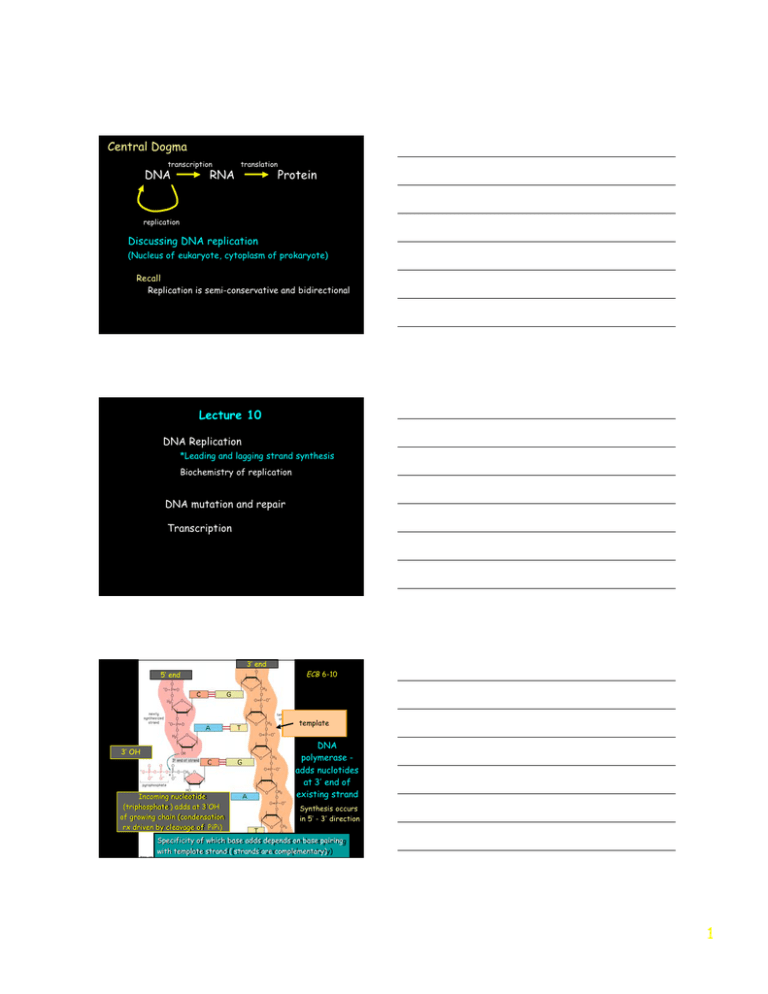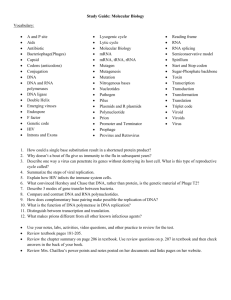Central Dogma DNA RNA Protein
advertisement

Central Dogma transcription DNA translation RNA Protein replication Discussing DNA replication (Nucleus of eukaryote, cytoplasm of prokaryote) Recall Replication is semi-conservative and bidirectional Lecture 10 DNA Replication *Leading and lagging strand synthesis Biochemistry of replication DNA mutation and repair Transcription 3’ end 5’ end ECB 6-10 template 3’ OH Incoming nucleotide nucleotide (triphosphate triphosphate) adds at at 33’OH of growing chain chain (condensation (condensation rx driven by by cleavage cleavage of of PiPi) PiPi) DNA polymerase adds nuclotides at 3’ end of existing strand Synthesis occurs in 5’ - 3’ direction Specificity of of which which base base adds adds depends dependson onbase basepairing pairing with template template strand strand((strands strandsare arecomplementary) complementary) 1 Problem: Strands are antiparallel; DNA made only 5’ to 3’ ECB 6-11 Fork moves at rate of ~1000 nucleotides/sec in prokaryotes (~100 NTs/sec in humans) Leading and lagging strands Replication fork is asymmetrical Lagging strand synthesis occurs from RNA primer ECB 6-16 2 Other Proteins at Replication Fork ECB 6-17 Leading strand strand 06.5-DNA_replication_fork.mov Lagging strand strand Helicase unwinds DNA duplex; breaks H bonds; requires ATP Single stranded binding proteins coat strand and prevent renaturation Sliding clamp keeps DNA polymerase bound Lecture 10 DNA Replication Leading and lagging strand synthesis Biochemistry of replication *DNA mutation and repair Transcription ECB 6-19 Mutation: a permanent change in DNA sequence 3 Incidents of cancer per 100,000 women Mutations accumulate with age and cause cancer Cancer = loss of control of the cell cycle ECB 6-20 Age (years) Mutations and Repair During Replication: Incorrect nucleotide incorporated Post Replication: Many sources of DNA damage Cell mechanism to reduce: proofreading Cell mechanism to reduce: Many mechanisms of repair Mistakes during replication cause mutations ECB 6-21 4 3’ end 5’ end Proofreading DNA Polymerase 3’ OH -Catalyzes phosphodiester bond formation -Has exonuclease activity polymerase Incoming deoxyribonucleoside triphosphate 5’ end -Performs proofreading Proofreading mechanism 3’ 5’ T AG 5’ Exonuclease activity removes the incorrect nucleotide Polymerase activity then adds correct nucleotide After proofreading, mistakes about 1/10 7 nucleotides See ECB 6-13 Replication 5’ Triphosphate Energy from PP At 5’ end Replication 3’ OH PP Energy from pyrophosphate Error Error Incorrect dNTP removed Incorrect dNTP removed No PPP left At 5’ end Correct dNTP but cannot be added 3’ OH available Energy from pyrophosphate Corrected! Proofreading requires 5’ to 3’ DNA synthesis ECB 6-15 5 Mutations and Repair During Replication: Incorrect nucleotide incorporated Post Replication: Many sources of DNA damage Causes of Errors: Deamination Depurination Pyrimidine dimers Post-replication repair also removes 99% of errors made in replication; Final error rate 1/10 9 NT Cell mechanism to reduce: proofreading Cell mechanisms to reduce: Many, involve removing damaged DNA Post-replication repair requires excision, resynthesis, ligation How damaged strand is recognized is not understood ECB 6-26 Lecture 10 DNA Replication Semi-conservative replication Biochemistry of replication End replication problem DNA mutation and repair *Transcription 6 Central Dogma transcription DNA translation RNA Protein Nucleus of eukaryote Cytoplasm of prokaryote replication ECB 7-1 What is a gene? Transcription control regions Double stranded DNA Coding region 5’ 3’ 3’ 5’ Protein A Protein B Protein C “each gene contains the information required to make a protein” How much of genome is composed of genes? Genome Projects: Bacteria - about 500 genes, most of genome Eukaryotes - about 20,000-40,000 genes, represents much less of genome Humans - about 30,000 genes, only a few percent of the total genome!!! Rest is repetitive DNA sequences - junk DNA Much of repetitive DNA is transposable elements that have mutated and can no longer move 15% of human genome is the L1 element 11% is Alu sequence, about 300 nucleotide pairs 7 DNA Structure: Double stranded Double helix Deoxyribonucleotides ATCG Organized as chromatin RNA Structure: Structure: Single stranded Variety of 3D structures Ribonucleotides AUCG Organized as RNA-protein complexes RNA Structure ECB 7-3 DNA codes for RNA Single-stranded product (5’ to 3’) Not H bonded to DNA RNA Polymerase Coded by DNA template strand (also called antisense strand) 8 DNA template A:U two H bonds New NTP Base pairing Rate ~ 30 NT/sec 4 major RNA classes RNA Polymerases Prokaryotes: One RNA Polymerase, composed of four subunits, plus additional factors that can confer promoter specificity Eukaryotes: Three RNA Polymerases (RNA Pol I, II, III), each composed of >10 different proteins, transcribe different types of genes. RNA Pol. I: synthesizes ribosomal RNA (rRNA) RNA Pol II: synthesizes mRNA (protein coding) and some small RNAs. RNA Pol III: synthesizes a variety of small RNAs, including tRNAs. 9 Lecture 10 DNA Replication Semi-conservative replication Biochemistry of replication End replication problem DNA mutation and repair Transcription-general *Prokaryotes Eukaryotes Prokaryotic Gene Organization Most genes in Operons: genes organized together, with one shared transcription start site One mRNA codes for Several proteins ECB 8-6 Transcription Initiation in Bacteria - overview RNA Polymerase contacts DNA, slides along strand, “looking” for promoter sequences. Promoter: “nucleotide sequence in DNA to which RNA polymerase binds and begins transcription.” ECB definition At the promoter, the RNA Polymerase binds tightly, opening up a small single stranded region. Transcription of one strand 10 Transcription Initiation in Bacteria (cont’d) Sigma subunit - binds RNA Pol., recognizes DNA sequences in the promoter approximately 35 and 10 bases ‘upstream’ of transcription start site +1 = transcription start site ECB 7-9 Initiation and termination of prokaryotic transcription ECB 7-9 Terminator (stop sequence) ECB 7-9 RNA Transcription termination in bacteria Hairpin loop causes polymerase to fall off DNA 11 Genome of Mycoplasma genitalium One of smallest genomes of any cell: codes for 470 proteins How does the cell know where to transcribe? … and when to transcribe? Proteins bind to specific DNA sequences, Some activate transcription, some repress Termed transcription factors Gene regulation in prokaryotes ECB 8-6 Operator sequence associated with promoter Regulatory protein (transcription factor) binds operator Repressible operon Default state is on, can turned off ECB 8-7 12 Inducible operon; lac operon Default state is off, turned on 13








